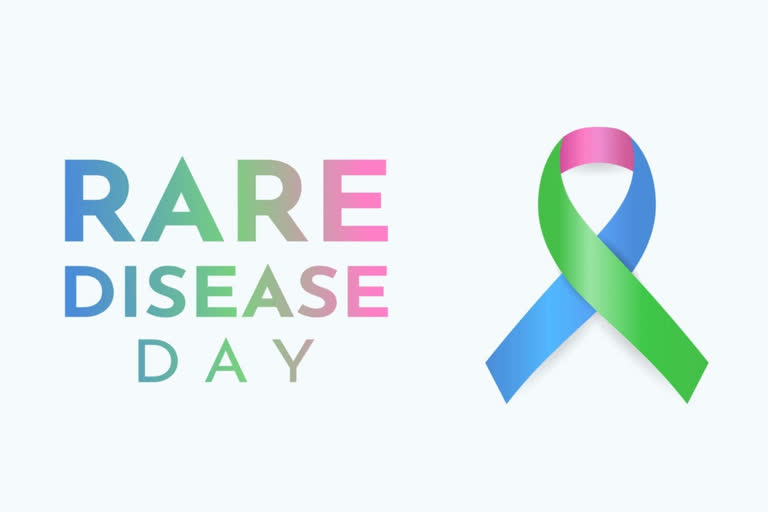Hyderabad: According to the data of the Indian Society for Clinical Research, 70 million people in India and 350 million people worldwide are currently suffering from rare diseases. 'Rare Disease' or 'Orphan Disease' is a category of diseases under which many rare diseases are included.
Generally, the victims of diseases under this category are unable to get treatment and help at the right time, due to the lack of awareness among the common people about these diseases, their rarity, and a delay in identifying their symptoms. In such situations, spreading awareness among the general public regarding the diseases that come under the category of orphan diseases has become a great need in this era.
Rare Disease Day is observed every year on February 28th to spread public awareness about rare diseases, their symptoms and diagnosis, and investigations related to them, besides giving a platform for discussion about them. In the year 2023, this day is observed around the theme “Share Your Colours”.
According to the World Health Organization (WHO), a rare disease is said to have a frequency of less than 6.5-10 per 10,000 people. According to the Organization for Rare Diseases India (ORDI), since the population of India is very large, here a disease which occurs in every 5,000 Indians or more can be classified as 'Rare'. At present, 263 rare diseases have been listed in India by ORDI. On the other hand, in European countries, those diseases in which one out of 2,000 citizens is affected are rare. However, according to statistics, 50 per cent of rare disease cases are seen in children.
According to experts, more than 7,000 diseases are considered rare diseases worldwide. But out of these 7000 rare diseases, only 5 per cent are curable. Genetic causes are responsible for 80 per cent of the total diseases in this category. Apart from genetic factors, in some cases, bacteria, viruses, infections or allergies can also be one of the responsible factors.
Also read:National Science Day 2023: "Global Science for Global Wellbeing"
People suffering from rare diseases usually do not get timely treatment because many of these symptoms are detected late. On the other hand, sometimes it becomes difficult to know about diseases based on symptoms because different symptoms can be seen in different people suffering from the same rare disease. Some of the rare diseases whose cases are seen more in India are as follows:
- Chorea-acanthocytosis.
- Achalasia cardia.
- Acromesomelic dysplasia.
- Acute Inflammatory Demyelinating Polyneuropathy.
- Acute lymphoblastic leukaemia - cancer of the blood, especially the white blood cells.
- Addison's disease.
- Alagille syndrome.
- Alkaptonuria.
- Hemophilia.
- Thalassemia.
- Sickle cell anaemia.
- Acanthamoeba Keratitis.
- Cysticercosis.
- Primary immunodeficiency in children.
- Auto-immune diseases.
- Creutzfeldt-Jakob disease
- Lysosomal Storage Diseases include Pompe disease, Hirschsprung's disease, Gaucher's disease, Cystic fibrosis, and Hemangioma.
- Certain types of muscular dystrophy.
The European Union established Rare Disease Day in the year 2008 with the aim of not ignoring rare diseases, spreading awareness about them among the general public and to try and encourage the person suffering from a rare disease in every possible way. After this, from the year 2011, many efforts are being made in this direction by the National Center for Advancing Translational Sciences and the National Institute of Health Clinical Center, and every year special events are organized on this day.
In addition to spreading public awareness about rare diseases, Rare Disease Day also provides an opportunity to discuss the challenges and issues such as the care of the victims and the need for scientific research for new treatments. Significantly, rare diseases are considered a big challenge, both in terms of care and treatment. Some cases of many of these diseases can be severe, long-lasting and even fatal.
At the same time, in some cases, the victims, especially children, can also become handicapped. A lot of efforts have been made by the government to prevent and cure these diseases. In the year 2017, the Ministry of Health and Family Welfare, Government of India, published a national policy for the treatment of 450 rare diseases, under which it was said to make a register of rare diseases.
Along with this, the classification of diseases was demanded based on categorizing these diseases like which diseases can be cured by one treatment and which diseases take time to treat etc. Not just this, based on classification, a recommendation was also made to give benefits to the victim under 'Pradhan Mantri Jan Arogya Yojana'.
The report also stated that more than half of the cases of rare diseases are diagnosed in children and 35 per cent of the children who die from such diseases are less than one year old. On the other hand, 10 per cent of those who lost their lives due to these diseases are children in the age group of 1 to 5 years and 12 per cent are in the age group of 5 to 15 years.
